
Digitaria is a genus of plants in the grass family native to tropical and warm temperate regions but can occur in tropical, subtropical, and cooler temperate regions as well. Common names include crabgrass, finger-grass, and fonio. They are slender monocotyledonous annual and perennial lawn, pasture, and forage plants; some are often considered lawn pests. Digitus is the Latin word for "finger", and they are distinguished by the long, finger-like inflorescences they produce.

Desmanthus is a genus of flowering plants in the mimosoid clade of the subfamily Caesalpinioideae of the pea family, Fabaceae. The name is derived from the Greek words δεσμός (desmos), meaning "bundle", and ἄνθος (anthos), meaning "flower". It contains about 24 species of herbs and shrubs that are sometimes described as being suffruticose and have bipinnate leaves. Desmanthus is closely related to Leucaena and in appearance is similar to Neptunia. Like Mimosa and Neptunia, Desmanthus species fold their leaves in the evening. They are native to Mexico and North, Central and South America. Members of the genus are commonly known as bundleflowers. Donkey beans is another common name and originated in Central America, where Desmanthus species are highly regarded as fodder for these domestic draught animals.

Cenchrus is a widespread genus of plants in the grass family. Its species are native to many countries in Asia, Africa, Australia, the Americas, and various oceanic islands.
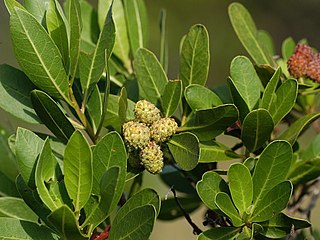
Conocarpus is a genus of two species of flowering plants in the family Combretaceae, native to tropical regions of the world. One of the species is a widespread mangrove species, and the other is restricted to a small area around the southern Red Sea coasts, where it grows alongside seasonal rivers.

Axonopus fissifolius is a grass species which is often used as permanent pasture.
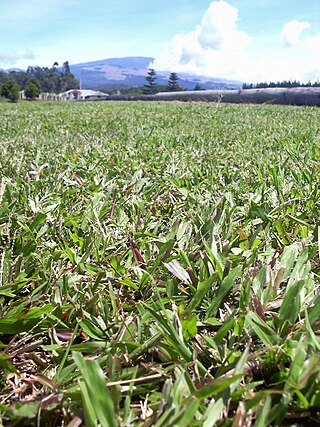
Axonopus compressus is a species of grass. It is often used as a permanent pasture, groundcover, and turf in moist, low fertility soils, particularly in shaded situations. It is generally too low-growing to be useful in cut-and-carry systems or for fodder conservation.

Chloris gayana is a species of grass known by the common name Rhodes grass. It is native to Africa but it can be found throughout the tropical and subtropical world as a naturalized species.

Anthephora is a genus of plants in the grass family, native to southwest Asia, Africa, the Americas, and various islands.
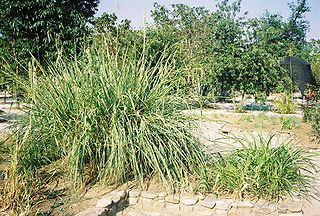
Tripsacum is a genus of plants in the grass family and native to the Western Hemisphere. Gamagrass is a common name for plants in this genus.

Urochloa, commonly known as signalgrass, is a genus of plants in the grass family, native to tropical and subtropical regions of Eurasia, Africa, Australia, the Americas, and various islands.
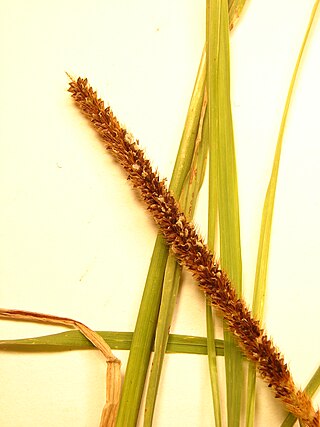
Setaria sphacelata is a tall African grass, also known as South African pigeon grass and African bristlegrass. It is native to tropical and subtropical Africa, and is extensively cultivated globally as a pasture grass and for cut fodder. This is a rhizomatous perennial grass producing flattened, hairless, blue-green stems up to 2 m tall. The inflorescence is a dense, narrow panicle of bristly, orange-tinged spikelets up to 25 cm long.
Bela "Bert" Grof was a Hungarian-born Australian agricultural researcher with contributions to grassland and forage research in the tropics.

Centrosema pubescens, common name centro or butterfly pea, is a legume in the family Fabaceae, subfamily Faboideae, and tribe Phaseolae. It is native to Central and South America and cultivated in other tropical areas as a forage for livestock.
Urochloa eminii, commonly known as Congo grass, is a species of forage crop in the family Poaceae that is grown throughout the humid tropics. With fast growth at the beginning of the wet season due to strong seedling vigour, ease of establishment, good seed production and yield and the ability to suppress weeds it has the ability to become developed into the most important forage crop planted in the tropics. With the aid of genomic tools to research the genotype and gain more information there is the ability to increase breeding programs which are currently rather limited.
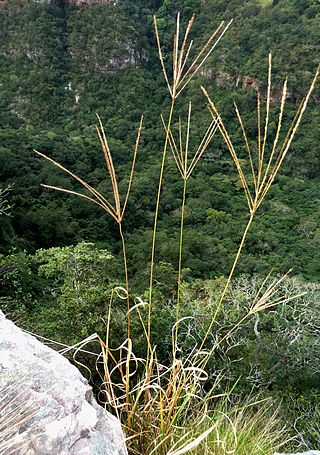
Digitaria eriantha, commonly known as digitgrass or Pangola-grass, is a grass grown in tropical and subtropical climates. It grows relatively well in various soils, but grows especially well in moist soils. It is tolerant to droughts, water lodging, suppresses weeds and grows relatively quickly after grazing. This grass demonstrates great potential for farmers in Africa in subtropical and tropical climates, mostly for livestock feed.

Urochloa nigropedata, commonly known as spotted brachiaria, is a perennial grass belonging to the grass family (Poaceae). It is native to Southern Africa in the tropical regions of South Africa and East Africa. Urochloa nigropedata is used as fodder grass in Namibia.

Neustanthus is a monotypic genus of flowering plants belonging to the pea family Fabaceae and its tribe Phaseoleae. The only species is Neustanthus phaseoloides, called tropical kudzu. This species is a forage crop and cover crop used in the tropics. It is known as puero in Australia and tropical kudzu in most tropical regions.

Urochloa mutica, commonly known as para grass, buffalo grass, Mauritius signal grass, pasto pare, malojilla, gramalote, parana, Carib grass, and Scotch grass, is a species of grass. Despite its common name of California grass, it does not occur in California; it is native to northern and central Africa and parts of the Middle East, where it is cultivated for fodder. It was introduced elsewhere and it is now cultivated throughout tropical regions of the world for this purpose.

Lippia abyssinica, or koseret, is a species of flowering plant in the verbena family, Verbenaceae. It is endemic to Ethiopia but cultivated throughout tropical African countries. The specific epithet abyssinica derives from Latin and means 'of or from Ethiopia (Abyssinia)'.

















